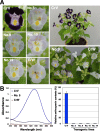Application of the CRISPR/Cas9 system for modification of flower color in Torenia fournieri
- PMID: 30518324
- PMCID: PMC6280492
- DOI: 10.1186/s12870-018-1539-3
Application of the CRISPR/Cas9 system for modification of flower color in Torenia fournieri
Abstract
Background: CRISPR/Cas9 technology is one of the most powerful and useful tools for genome editing in various living organisms. In higher plants, the system has been widely exploited not only for basic research, such as gene functional analysis, but also for applied research such as crop breeding. Although the CRISPR/Cas9 system has been used to induce mutations in genes involved in various plant developmental processes, few studies have been performed to modify the color of ornamental flowers. We therefore attempted to use this system to modify flower color in the model plant torenia (Torenia fournieri L.).
Results: We attempted to induce mutations in the torenia flavanone 3-hydroxylase (F3H) gene, which encodes a key enzyme involved in flavonoid biosynthesis. Application of the CRISPR/Cas9 system successfully generated pale blue (almost white) flowers at a high frequency (ca. 80% of regenerated lines) in transgenic torenia T0 plants. Sequence analysis of PCR amplicons by Sanger and next-generation sequencing revealed the occurrence of mutations such as base substitutions and insertions/deletions in the F3H target sequence, thus indicating that the obtained phenotype was induced by the targeted mutagenesis of the endogenous F3H gene.
Conclusions: These results clearly demonstrate that flower color modification by genome editing with the CRISPR/Cas9 system is easily and efficiently achievable. Our findings further indicate that this system may be useful for future research on flower pigmentation and/or functional analyses of additional genes in torenia.
Keywords: CRISPR/Cas9; Flavanone 3-hydroxylase; Flower color; Genome editing; Torenia fournieri.
Conflict of interest statement
Ethics approval and consent to participate
Not applicable
Consent for publication
Not applicable
Competing interests
The authors declare that they have no competing interests.
Publisher’s Note
Springer Nature remains neutral with regard to jurisdictional claims in published maps and institutional affiliations.
Figures



References
-
- Akita Y, Morimura S, Loetratsami P, Ishizaka H. A review of research on ower-colored mutants of fragrant cyclamens induced by ion-beam irradiation. Horticult Int J. 2017;1:90–91.
MeSH terms
Substances
Grants and funding
LinkOut - more resources
Full Text Sources
Other Literature Sources

